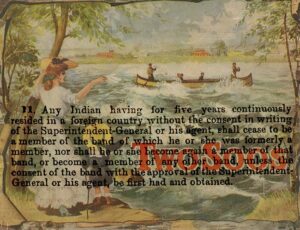Opinion: The Five-Year Rule and Band Membership along the US-Canada border

By Karl S. Hele
From 1876 to 1952, individuals residing outside of Canada for five consecutive years were to be struck from Band lists by Indian Affairs according to the Indian Act. Apparently, according to James C. Phipps, Deputy Superintendent of Indian Affairs at Manitowaning in 1877, the 1876 Indian Act’s imposition of the five-year rule claimed that it was “in accordance with a long established rule of the Dept.” Phipps was referencing the previous practices of the Indian Department, created in the 1830-40s, aimed at limiting presents and stopping treaty annuities from flowing to First Nations residents in territories claimed by the United States. For instance, Garden River First Nation saw its membership lists reduced between 1850-60 as the government purged ‘American Indians’, Métis, and those who looked white. Alternatively, in 1869 when H.-L. Langevin, Superintendent-General of Indian Affairs and Secretary of State of Canada, wrote to William Plummer, Superintendent Indian Affairs, to inform agents, such as Joseph Wilson at Sault Ste. Marie that “those who have come from the U.S. are not entitled and must be made to leave the reserve.” Simply, this “long established rule” was a colonial policy designed to placate U.S. and British-Canadian interests in establishing dominion over Indians.
The “rule” was incorporated and formalized into the 1876 Indian Act as Section 3; it was moved to Section 13 in later Acts. After learning of the rule, Garden River Band Council stated in 1876 that, “when the treaty was made, no restrictions as to residence was contained in it.” A council at Manitowaning also objected to the ‘striking’ of American Indians from annuity lists. Indian Affairs records are replete with Band Councils along the international border demanding that the government stop enforcing and repeal this rule. Section 13 of the Indian Act was finally repealed by the federal government in 1952, but without people being restored to the lists. The restoration of status would only occur following Bill C-31 in 1985.
While it is difficult to determine the number of people affected by the ‘rule’, you can glimpse personal stories and numbers contained within Indian Affairs records. For instance, in 1883-84, the Agent for the Fort Frances Agency struck Tibisobkeejeckwapo’s wife from the paylist because she was an American Indian. Likewise, in the Sault Ste. Marie Agency in 1891, the Agent determined that Stephen Bogalow, Joseph Greensky, Mrs. Mary Sah gah quan as well as her children Jacob and Henry, and Mrs. Mary Tegoosh and her children Joseph, John, Philomen, and Margaret, were not entitled to be Garden River Band members because they were American Indians. These individuals were directly related to or descended from signatories to the 1850 Robinson-Huron Treaty. Despite this connection to a British-Canadian treaty, residency in the US or acceptance of American government annuities or largesse negated your rights.
Nonetheless, under Section 13, a former member could be readmitted provided “the consent of such band, with the approval of the Superintendent General or his agent” was obtained. Most applications, even with the support of Chief and Council, were denied readmission by Indian Agents or Ottawa. For instance, Antwing Mezgun and family were denied membership in 1882 based on their acceptance of American treaty annuities and residency for a number of years in the US prior to returning to Garden River. Peter Tegosh was also denied based on his residency in the US and the fact that he was seen as a “trouble maker” by the Sault Agent.
Yet Indian Agents were not always successful in removing or preventing people being reinstated. Rebecca Puhgwahgenene was readmitted to the Garden River Band List in 1882 after her father, Chief Puhgwahgenene, Council and Band members petitioned the Agent and Indian Affairs. Similarly, after being struck from the Garden River list, Peter Biron appealed what he saw was an arbitrary action by the Agent William Van Abbot in 1886. Writing directly to Indian Affairs, Biron argued that while he had indeed lived and worked in the US, he had not resided there for five consecutive years. After an investigation, Indian Affairs reminded Abbot that according to Section 13 residency needed to be “continuous.” Abbot was ordered to restore Biron’s membership. Regardless, Indian Affairs denied many more applicants in their quest to regain/restore Treaty and Band rights.
The ‘five-year rule’ also generated questions for the administration of Indian Affairs. Agents wondered if individuals restored to the Band or Treaty Lists should receive annuities for the time they were not on the list; or whether Canadian Indians married to American Indians could receive annuities; or, whether American Indians married to Canadian Indians resident in Canada were entitled to inclusion on Band or Treaty Lists? Over time, the answers to these questions were determined to be NO, based on other sections of the Indian Act or through manipulation of interpretation of past policies and actions.
Overall, the ‘rule’ was an attack on our people who were utilizing our territories without reference to colonially imposed boundaries. The very notion that the US-Canada border could determine rights goes to the very heart of the Doctrine of Discovery. The Canadian Government repealed Section 13 when it overhauled Indian Act in 1951-2. Nonetheless, individuals who lost their rights had to wait until 1985 when Bill C-31 undid Section 13 removals. Nevertheless, the number of people ‘lost’ to our nations who reside along the colonial borderlands remains relatively unknown and their stories generally silent outside of reserve communities.

